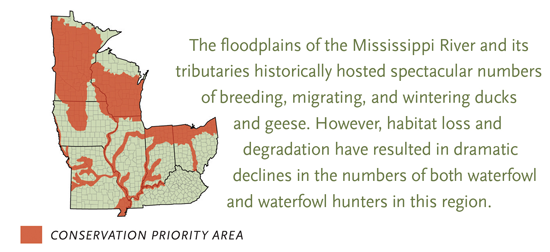Conservation: DU's Big Rivers Initiative
Conserving the Mississippi River and its tributaries for waterfowl, other wildlife, and people
Conserving the Mississippi River and its tributaries for waterfowl, other wildlife, and people
-By Chris Sebastian
Located in the heart of the Upper Mississippi River watershed, Ducks Unlimited's Big Rivers Initiative focuses on the restoration, enhancement, and protection of wetlands used by millions of waterfowl migrating between their breeding and wintering grounds each year. These habitats are vital not only to waterfowl and other wildlife, but also to the many people who live in this region. The diverse waterfowl habitats found in the Big Rivers Initiative area include bottomland forest, scrub-shrub, and emergent wetlands; extensive beds of submerged aquatic vegetation; and the Mississippi River and its tributaries. Conserving these habitats is crucial to the well-being of a variety of waterfowl species, and this initiative is working to "set the table" for the birds as they migrate north and south each year.
But the Big Rivers Initiative area is home to much more than wetlands and waterfowl. The region has vast human, political, and philanthropic capital, accounting for 18 percent of the U.S. population and 29 percent of DU members nationwide. The waterfowling tradition is strong in this eight-state area, which is home to a quarter of America's active waterfowl hunters and a quarter of DU's mission-critical Major Sponsors.
The floodplains of the Mississippi River and its tributaries historically hosted spectacular numbers of breeding, migrating, and wintering ducks and geese. However, habitat loss and degradation have resulted in dramatic declines in the numbers of both waterfowl and waterfowl hunters in this region. The area has already lost an estimated 67 percent of its original wetlands, and wetland losses continue at the rate of 1 percent annually.
DU is seeking to raise $5 million in philanthropic funds to achieve its conservation goals in the Big Rivers Initiative area. Funding derived from this initiative enables DU to conduct important science, public policy, and outreach work supporting its conservation programs. DU's efforts seek to maximize benefits for continental waterfowl populations by restoring, enhancing, and protecting wetland complexes on public and private lands. These habitats provide crucial feeding and resting areas for waterfowl during the spring and fall migrations and also support significant numbers of waterfowl that breed in this region. DU's public policy work largely focuses on ensuring funding for its conservation programs from sources such as the North American Wetlands Conservation Act, the Farm Bill, dedicated state funding, and DU license plates. DU also supports federal and state policies that help conserve existing wetland habitats in this region.

Migratory waterfowl are a shared continental resource. Thus, DU must work across North America to ensure a bright future for these magnificent birds and the people who enjoy them. By contributing to DU's Big Rivers Initiative, you will be supporting important waterfowl habitat conservation work not only in this region but also in the Prairie Pothole Region, Western Boreal Forest, and high-priority areas of eastern Canada, where the majority of North America's waterfowl are produced.
Residents of the Big Rivers Initiative area know the importance of conserving healthy rivers and their associated wetlands. Your gift to Ducks Unlimited is truly the greatest contribution you can make to this continent's wetlands and waterfowl. Every dollar you give to DU is leveraged multiple times to create a conservation impact far beyond your initial gift. In addition, DU invests at least 80 cents of every dollar it receives in its conservation mission.
The Big Rivers Initiative area is home to deep waterfowling roots, large numbers of hunters and other conservationists, and a strong family of DU members and Major Sponsors. Start making a difference right now for waterfowl, waterfowl hunters, and future generations of wildlife and people by making your gift to DU's Big Rivers Initiative today. For more information on how you can support this and other DU initiatives, visit ducks.org/DUinitiatives.
Chris Sebastian is a public affairs coordinator in DU's Great Lakes/Atlantic Region.
Ducks Unlimited uses cookies to enhance your browsing experience, optimize site functionality, analyze traffic, and deliver personalized advertising through third parties. By continuing to use this site, you agree to our use of cookies. View Privacy Policy